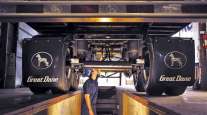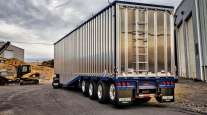Senior Reporter
Rental/Lease Trailer Inventory Rises in 2021

[Stay on top of transportation news: Get TTNews in your inbox.]
Fleet demand for new trailers is strong but production at trailer makers, cut back and slowed down by supply chain issues, can’t keep up.
Used trailers for sale are as scarce as gold nuggets.
The number of rental/lease trailers rose this year. Now those are mostly taken.
A 2021 inventory of rental/lease trailers put their number at 585,000, or 6.5% higher compared with a year earlier, according to a recent survey of certain North American companies in that sector.
The rental/lease trailers equate to 10% to 14% of the total population of all North American trailers of all types and ages, WillGo Transportation Consulting noted in its survey. Dry vans accounted for 82% of these.

Willmott
“The use of rental/lease fleets today is simply to just to fill capacity because of the unavailability of either new or used trailers [to buy] in the marketplace. It is kind of the perfect storm because most of these rental/lease companies are running darn close to 100% utilization; with a lot of empty lots around the country,” Charles Willmott, CEO of WillGo Transportation Consulting, told Transport Topics.
The growth in the number of trailers this year occurred despite disruptions in the available supply of new trailers due to the COVID pandemic, and the continued scarcity of used trailers in the secondary market, the Petoskey, Mich.-based company, headed by Willmott, found.
Some of this growth can be explained by “frantic ordering” of new trailers in the third and fourth quarters of 2020 as manufacturing reopened, the survey reported. “And some of this change might also be explained by improved care and accuracy in the survey data submitted by respondent companies. Additional growth could also be attributed to the acquisition of smaller rental fleets not previously identified by annual survey respondents.
“Growth through acquisition of used trailers was not a factor as virtually no used trailers were available throughout the year.”
WillGo surveyed 61 companies with fleets over 500 trailers, including 11 in Canada and 50 in the U.S., with the most significant change being two companies moving up into the 20,000-plus category.
It identified nine companies with 20,000 or more trailers, five with 10,000-19,999, 40 with 1,000-9,999 trailers and seven others with 500-999 trailers.
About 33% of survey respondents shared their estimate of current revenue by customer segment. The dominant share of revenue for the total rental/lease industry comes from over-the-road trailers; seven of 23 of the smaller fleets responding reported 80-100% of revenues from storage/local delivery.
“While cartage and storage customers have always been the backbone of smaller, local rental/lease operations with older fleets, we believe that the overall industry shift away from dependency on national OTR carriers will continue as the smaller, more regional lessors grow and become more mainstream,” the survey reported.
Willmott said he is even reading reports that some companies are focusing more on storage/cartage markets nearly three decades after abandoning those markets for 100% focus on OTR.
Fifty-three-foot air ride, swing door vans continue to be the vast majority of dry vans in the total population, but most new rental/lease trailer acquisitions are spec’ed with spring ride suspensions.

Research shows that 41% of technicians leave the industry within the first two years. Host Michael Freeze asks, how can technician recruiters and maintenance leaders decrease that percentage? We talked with Ana Salcido of Navistar and Stacy Earnhardt of TMC. Hear a snippet above, and get the full program by going to RoadSigns.TTNews.com.
The survey also found the significant shift, seen in the past three years, to increased reliance on short-term trailer rental continues.
The survey noted brick-and-mortar branch locations are a key customer service feature in the trailer rental/lease business; longer drives to pick up or drop off rental trailers can be very costly. The 61 companies included in the survey have a total of 447 physical branch locations — over a third of the companies surveyed had only one to two branches, 11 others had 10-plus branches and 20 had 3-9 locations.
Willmott noted companies like Ryder, Penske, Ruan, Idealease, Nationalease and others have large fleets of trailers but are excluded from this study because their focus on tractors and trucks results in a fundamentally different business model from the survey’s trailer-focused lessors.
Also banks and capital equipment finance companies like WFEF and Element hold large portfolios of trailers but do not rent or offer “net” or “pure” leases on trailers.
Marine and domestic container and chassis lessors like FlexiVan, TAL/Triton, TRAC and DCLI are not included because they represent an entirely different equipment lease segment focused on the steamship and rail intermodal industry.
“In our census of trailer rental/lease equipment types, however, we do include containers rented for temporary storage and chassis rented to local drayage truckers,” he said.
Meanwhile, Willmott and Paul Menig, CEO at Business Accelerants, are looking into whether the trailer of the future is likely to be a lot more connected and intelligent.
Willmott said the big unanswered question is “what will that intelligence do to rationalizing the need for excess trailers. Will we turn the corner in more efficient use of trailers to the point where we won’t need as many?”
The Technology & Maintenance Council of American Trucking Associations will fund this new study focusing on refrigerated carriers with an emphasis on how they manage food safety with new technology and related maintenance implications.
The study gets underway as food safety issues continue to draw new concerns from regulators, food retailers put in place new requirements for suppliers and new sensor-based technologies proliferate with options for carriers.
Want more news? Listen to today's daily briefing below or go here for more info:




